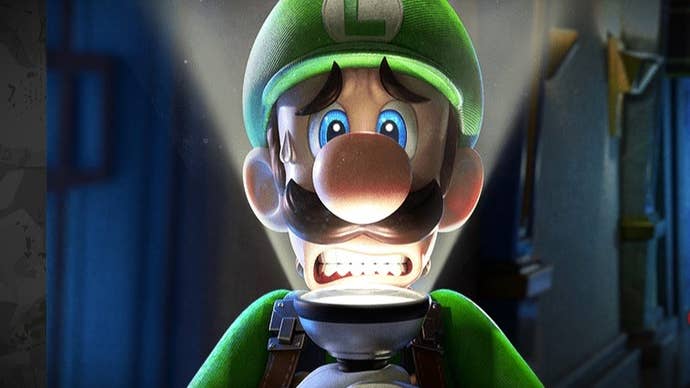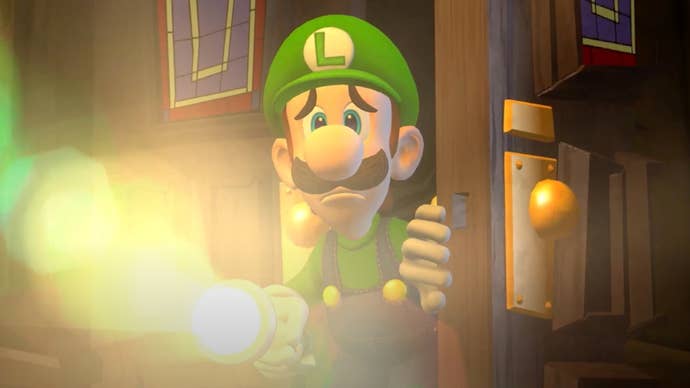Ghosts are a close-up.
Eventually they are, anyway.
Ghosts are details, which means that games have often struggled with them.

A reference to Resident Evil?
But also a statement of intent: close-ups, details, the glinting play of light on metalwork.
Here was a game in which the little domestic things would matter.

Unlike Luigi, anyway, you know what you’re getting into.
This is the series that always dims the lights, that always invites you inside.
It’s the series that revels in doors and what doors conceal.

It’s the Mario game that’s in love with human clutter.
“Rolling pins, lawnmowers, yarn,” the list reads in one section.
But it misses the point a little.
The rolling pin shifts back and forth and eventually clatters off the kitchen table.
The lawnmower rattles and huffs as it chews a path across a raggedy midnight lawn.
The yarn is caught and yanked and then spins and spins until it’s all flown off its reel.
It’s not enough to say that Luigi’s Mansion games are about domestic objects.
Yet for games, because games are weird, it’s the domestic stuff that seems the most dazzling.
This is what still makes me stop and think every time I play a Luigi’s Mansion game.
Lots of ghosts in games, and ghosts of all kinds.
I marveled at your vacuum that worked like an actual vacuum.
This has been the case throughout all the games.
A dinner table set for a feast.
Ladders, watering cans in the shed.
Grates with mice moving behind them in the darkness.
So many rugs - and they move like rugs and can get snagged on your vacuum.
So many standard lamps that will rock back and forth and have lightbulbs that might dim.
I never really think of Nintendo’s designers as living around standard lamps and having to deal with lightbulbs.
Ghosts often animate this stuff, as Luigi walks the haunted halls and tries to straighten everything out.
But it’s the designer’s minds that really lurk in the walls and rap on the false panels.
Here’s the close-up response.
Luigi pulls down a Murphy bed.
Luigi shatters an old suitcase and finds a stack of coins inside.
And in these moments, I see - well, I see two things actually.
The broad strokes of the games hadn’t changed that much.
What had changed was that the games no longer had to be purely broad strokes anymore.
I saw that with Luigi’s Mansion back on the GameCube.
Here was a 3D game that didn’t have to expend all its energy just making the 3D work.
It could embellish it - with rugs and mirrors and cobwebs and all that other stuff.
The other thing takes me further back.
A wardrobe might be a bit of business.
A shower curtain hiding a bath might be a bit of business.
A baby’s crib might be a bit of business.
These are Mario games that feel like they have practical sets, practical effects.
Going into this I didn’t think I’d reference film at all.
This is hardly what people talk about when they talk about games becoming more cinematic.
Like the old days.
Like light flickering in the darkness.